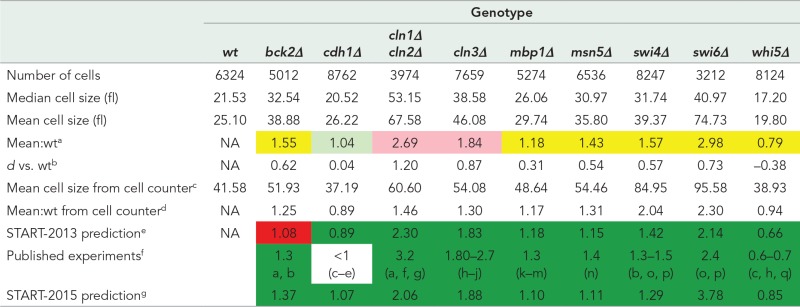TABLE 1:
Cell size phenotypes of single mutants.
 |
All cell sizes are given in femtoliters.
aRatio of the mean cell size of the mutant strain (all replicates pooled) compared with wild-type (wt) cells (all replicates pooled) from live-cell microscopy experiments. Light green cells, mean cell size is the same as wt (small effect size, d ≤ 0.2). Yellow cells, mean cell size is smaller or larger than wt with a medium effect size (0.2 < d < 0.8). Pink cells, mean cell size is smaller or larger than wt with a large effect size (d ≥ 0.8).
bCohen’s d effect size for log-transformed cell sizes (see Materials and Methods).
cMean cell size from automated cell counter measurements (see Materials and Methods). Most measurements are of a single biological replicate. When multiple replicates were measured, the number is the mean from the replicates.
dRatio of the mean cell size to the mean cell size of the wt strain from automated cell counter measurements.
eSTART-2013 model–simulated mutant cell size at division relative to wt cell size at division. Dark green cells, measurements agree with model prediction. Red cells, measurements do not agree with model prediction.
fMean population cell size of mutants relative to wt cells reported in the literature as cited. Dark green cells, measurements agree with published observations. Uncolored cell, literature provides only relative cell size. a. Epstein and Cross (1994), b. Wijnen and Futcher (1999), c. Jorgensen et al. (2002), d. Schwab et al. (1997), e. Wasch and Cross (2002), f. Dirick et al. (1995), g. Tyers et al. (1992), h. Costanzo et al. (2004), i. Cross (1988), j. Tyers et al. (1993), k. Bean et al. (2005), l. Ferrezuelo et al. (2009), m. Koch et al. (1993), n. Queralt and Igual (2003), o. Nasmyth and Dirick (1991), p. Wijnen et al. (2002), q. de Bruin et al. (2004).
gRelative cell size prediction from current updated START-2015 model incorporating changes to better fit new data (see Discussion). Dark green cells, measurements agree with model prediction.
